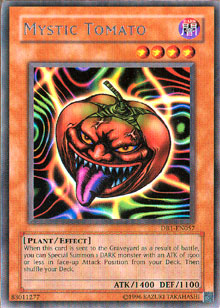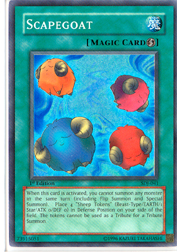I’m back with my second installment of Adjusting to a New Format. Just to clarify, the first edition of this article (with the monster list) was formulated before the Top 8 decks of Shonen Jump Championship Houston were released. However, the results of that event make it a lot easier to assess which spell and trap cards will function well in our build. Let’s do a brief recap of the monster lineup.
 2 Zaborg the Thunder Monarch
2 Zaborg the Thunder Monarch
3 Cyber Dragon
3 Hydrogeddon
3 Gravekeeper’s Spy
1 Sangan
1 Treeborn Frog
1 D. D. Warrior Lady
1 D. D. Assailant
1 Exiled Force
1 Spirit Reaper
1 Don Zaloog
2 Legendary Jujitsu Master
2 Mystic Tomato
This is a very solid line to take against the variety of decks in the average North American metagame. While it was difficult to predict the volatile nature of the environment, most players could deduce that cards like Card Trooper and Stratos would impact the game. They’re big, and they replace themselves either when summoned or when destroyed.
In light of SJC Houston, I think the use of Spy, Hydrogeddon (to force huge damage swings against Card Trooper and Gadgets), and Cyber Dragon in triples is top notch. We’ll need to back this sort of attack with some spell or trap removal, but the general strategy of the deck remains intact and very powerful. Let’s take a look at our possible options for the spell line.
Adjusting the Spell Lineup in Light of the New Card Pool
I believe the new group of spells that should be considered for most decks can be referenced as such:
1 Snatch Steal
1 Premature Burial
1 Heavy Storm
1 Mystical Space Typhoon
1 Nobleman of Crossout
1 Confiscation
I think one of the big mistakes at Houston was an unwillingness to main deck (or even side deck) Confiscation. It can dictate how you play a certain hand versus an uncertain strategy, and can cripple many of the win conditions that a deck such as Bazoo/Return can play. For example, imagine a hand such as Bazoo the Soul-Eater, Card Trooper, Return from the Different Dimension, a second Return, and Smashing Ground. Confiscation would strip the hand of Card Trooper, leaving a rather useless set of cards left to support.
The other cards are self-explanatory. While I understand certain decks will forgo Mystical Space Typhoon and Confiscation (Kris Perovic’s masterful combo-based deck is a great example of one that rightly chose to put Confiscation in the side), most decks will want to run the full list.
The rest of the spell cards get a bit trickier. However, I’d like to include:
1 Reinforcement of the Army: This card is a no-brainer for our monster lineup. It leads to either monster removal, stable field presence, or hand disruption. One Reinforcement for four Warriors is a good option and helps round out our deck while giving it versatility and stability.
 1 Scapegoat: Again, in an uncertain format, Scapegoat is one of the best stabilizers we can use. It helps mitigate the impact of Heavy Storm, especially when one of the cards you’re losing is Snatch Steal. It also provides a solid defensive set up against the opponent’s attackers. I’d say it’s a much better option against cards like Jinzo, Return from the Different Dimension, and Card Trooper than other defenses like Sakuretsu Armor.
1 Scapegoat: Again, in an uncertain format, Scapegoat is one of the best stabilizers we can use. It helps mitigate the impact of Heavy Storm, especially when one of the cards you’re losing is Snatch Steal. It also provides a solid defensive set up against the opponent’s attackers. I’d say it’s a much better option against cards like Jinzo, Return from the Different Dimension, and Card Trooper than other defenses like Sakuretsu Armor.
2 Smashing Ground: I generally dislike playing this card, but it’s a necessary choice against an environment comprised of huge threats like Jinzo, the Monarchs, and Dark Magician of Chaos. While it’s less than desirable against cards like Hydrogeddon and Gravekeeper’s Spy, the fact that it’s a spell, and a proactive piece of monster removal makes it entirely necessary.
1 Creature Swap: The synergy with the rest of this deck is too strong to ignore for a special case like Creature Swap. Swapping over Mystic Tomato to bring out Spirit Reaper for hand disruption or Sangan for tricky damage is too powerful to ignore. One copy for stability purposes should suit us well, seeing as how two copies of the card can get quite hairy.
1 Book of Moon: Again, this combo-based card has too much synergy to ignore. You can stop cards that would threaten your monsters like Smashing Ground or Snatch Steal. You can reuse effects like those of Gravekeeper’s Spy and Legendary Jujitsu Master. The large number of monsters that don’t lose you a card through battle in the long run makes activating Book in response to Sakuretsu Armor a decent proposition.
Adjusting the Trap Lineup in Light of the New Card Pool
Again, let’s take a look at the traps. Few modifications to the pool were made, so we’re going to simply add one Torrential Tribute, Mirror Force, Call of the Haunted, and Ring of Destruction each, accompanied by two copies of Dust Tornado. The Tornado should help push through our attacks, ward against Return from the Different Dimension, and provide general stability.
This gives us a decklist that looks something like this.
Monsters: 22
2 Zaborg the Thunder Monarch
3 Cyber Dragon
3 Hydrogeddon
3 Gravekeeper’s Spy
1 Sangan
1 Treeborn Frog
1 D. D. Warrior Lady
1 D. D. Assailant
1 Exiled Force
1 Spirit Reaper
1 Don Zaloog
2 Legendary Jujitsu Master
2 Mystic Tomato
Spells: 12
1 Snatch Steal
1 Premature Burial
1 Heavy Storm
1 Mystical Space Typhoon
1 Nobleman of Crossout
1 Confiscation
2 Smashing Ground
1 Book of Moon
1 Scapegoat
1 Creature Swap
1 Reinforcement of the Army
Traps: 6
2 Dust Tornado
1 Mirror Force
1 Ring of Destruction
1 Torrential Tribute
1 Call of the Haunted
This is a very neat and tidy list. It is very stable, and all of its choices are designed to combat the emerging environment.
Final Thoughts
The dawn of any new environment brings with it numerous innovations and changes. Duelists should approach these new events with caution, since different pieces of tech and metagame trends can collapse any well-laid plans.
If not for the inspiration that some of our best duelists received from around the world, Card Trooper, Destiny Heroes, and Gadgets probably wouldn’t be nearly so popular. However, those tactics and trends have morphed into very powerful threats in this environment.
The build I selected, with sensible reasoning behind each choice, provides a solid and stable template from which to make your side deck choices. Hopefully it will provide key insight into how the adaptive deckbuilder makes his or her selections.